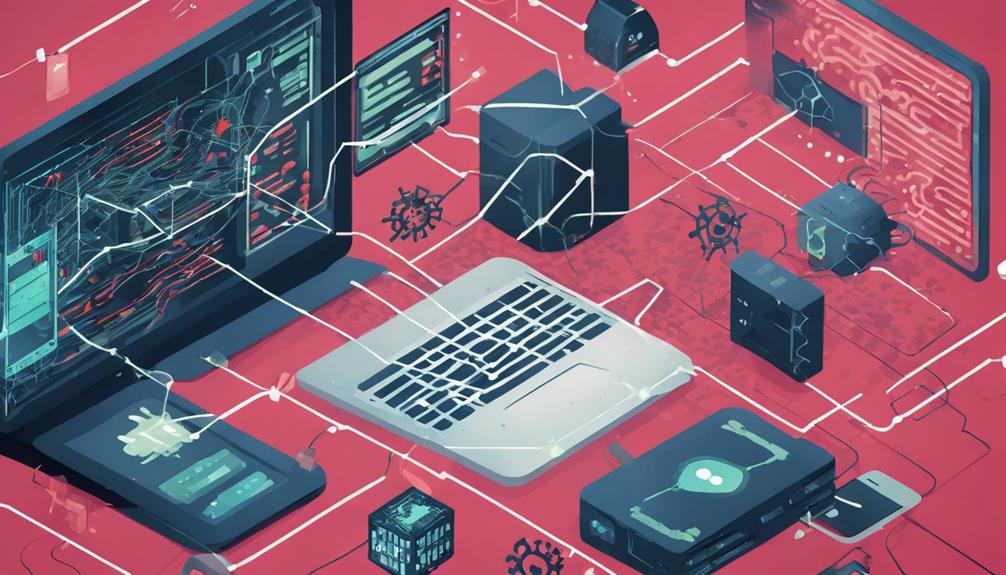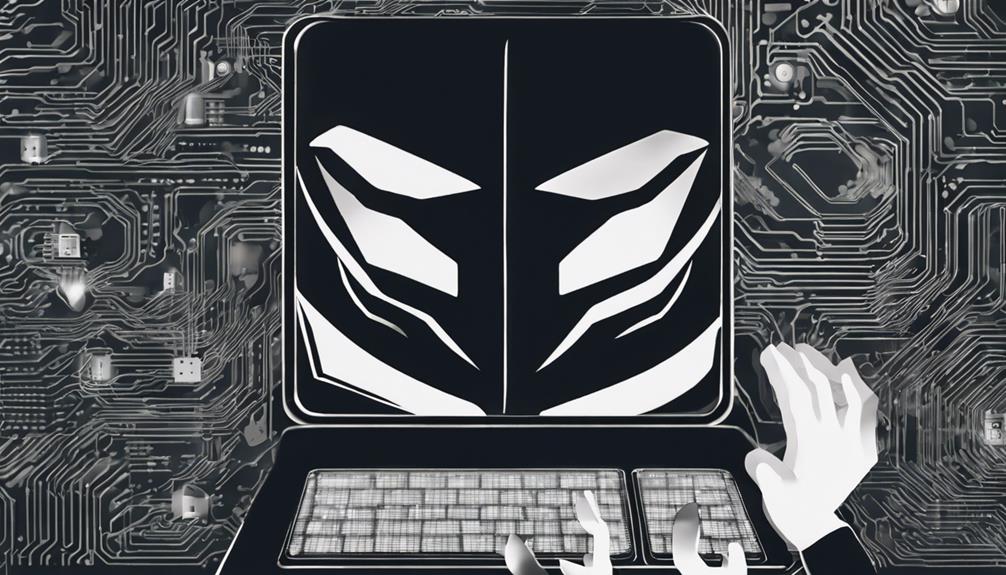Understanding the risks of AI in cybersecurity is vital as AI enhances cyberattacks, automates malware threats, and poses physical safety concerns in critical infrastructure. Privacy risks, data manipulation dangers, impersonation threats, and sophisticated cyber attacks further amplify vulnerabilities. To safeguard against these perils, implementing robust security measures, proactive threat detection, and continuous AI model training is essential. Embracing evolving cyber defenses, prioritizing AI-driven security solutions, and collaborating on intelligence sharing are key strategies. Stay informed to bolster your cybersecurity readiness and thwart emerging threats effectively.
Key Takeaways
- AI-enhanced cyberattacks increase sophistication and efficiency.
- Automated malware threats adapt and target vulnerabilities.
- AI-driven security solutions are crucial for real-time response.
- Privacy risks escalate with detailed profile creation in AI systems.
- Unauthorized access to AI models poses intellectual property theft risks.
AI Cyberattack Optimization
Leveraging artificial intelligence (AI) in cyberattacks has become a prevalent strategy for threat actors seeking to enhance the efficiency and sophistication of their malicious activities. By utilizing AI algorithms and machine learning models, cybercriminals can automate and scale their attacks, leading to more targeted and complex threats against organizations. These advanced technologies enable threat actors to analyze vast amounts of data quickly, identifying vulnerabilities and crafting tailored strategies for infiltration.
Furthermore, AI-powered tools streamline the deployment of malware and phishing campaigns, allowing for rapid and widespread attacks that can bypass traditional security measures. Threat actors also leverage AI to mimic human behavior, evade detection, and execute more effective social engineering tactics.
This poses significant challenges for cybersecurity defenders, as the use of AI in cyberattacks continues to evolve and adapt at a rapid pace. Organizations must stay vigilant and enhance their defense mechanisms to counter these increasingly sophisticated threats effectively.
Automated Malware Threats

Automated malware threats pose a serious risk to cybersecurity. They infect systems without human intervention and rapidly evolve to evade detection. AI-powered malware can adapt to security measures and target vulnerabilities with precision, leading to potential data breaches and financial losses.
To combat these sophisticated threats, organizations must invest in advanced cybersecurity tools and strategies. Proactive threat detection and response are essential.
AI Malware Detection
AI-powered malware detection systems utilize machine learning algorithms to identify and analyze malicious software, enhancing the accuracy and efficiency of threat identification in cybersecurity.
These systems can detect new and evolving malware threats by analyzing patterns and behaviors, thereby mitigating security risks associated with malicious data.
By automating the process of analyzing vast amounts of data, AI enhances malware detection accuracy, enabling cybersecurity teams to respond faster and prevent potential damage.
Continuous training of AI models is crucial in improving the ability to process and analyze advanced malware attacks effectively.
Leveraging AI in malware detection not only streamlines the identification of threats but also empowers organizations to stay ahead of cyber threats in an ever-evolving digital landscape.
- Detect new and evolving malware threats by analyzing patterns and behaviors.
- Mitigate security risks associated with malicious data.
- Automate the process of analyzing vast amounts of data.
- Respond faster to malware threats and prevent potential damage.
- Continuously train AI models to improve the ability to process and analyze advanced malware attacks.
Adaptive Threat Response
Sophisticated cyber threats, known as automated malware threats, exhibit adaptive behaviors that pose a significant challenge to traditional cybersecurity defenses. These automated malware threats leverage AI techniques to constantly evolve, making it difficult for security measures to keep up. By adapting their tactics and code, AI-powered malware can bypass conventional signature-based detection systems, rendering them less effective.
To combat these adaptive threats, organizations need to implement advanced AI-driven security solutions capable of real-time detection and response. The table below highlights key aspects of adaptive threat response in cybersecurity:
| Aspect | Description |
|---|---|
| Definition | Automated malware threats that can adjust their behavior to evade detection. |
| AI Utilization | Malware authors use AI techniques to create sophisticated malware that learns and adapts to security measures. |
| Challenge to Defenses | Automated malware threats pose difficulties for traditional cybersecurity defenses due to their ability to evolve and change tactics. |
| Bypassing Detection | AI-powered malware can evade signature-based detection systems by constantly changing its code and behavior. |
| Required Solutions | Organizations need advanced AI-driven security solutions to effectively detect and respond to adaptive malware threats in real-time. |
Evolving Cyber Defenses
With the increasing sophistication of automated malware threats leveraging AI capabilities, the evolution of cyber defenses has become imperative to address the growing challenges posed by these dynamic cyber threats. AI-powered malware can adapt to security measures, making it harder to detect and mitigate.
Machine learning algorithms enable malware to learn and evolve, increasing the effectiveness of cyber attacks. Automated malware threats can exploit vulnerabilities faster and on a larger scale, posing significant risks to organizations. Defenders need advanced AI tools to keep up with the evolving tactics of automated malware and protect against cyber threats.
Implementing AI systems in cybersecurity can enhance threat detection and response capabilities. Continuous monitoring and analysis of network traffic can help identify suspicious patterns indicative of AI-powered malware.
Regularly updating security protocols and patches can mitigate the risks posed by evolving automated threats. Training cybersecurity professionals on responsible use of AI tools is essential to effectively combat automated malware.
Collaborating with industry peers and sharing threat intelligence can strengthen defenses against AI-driven cyber threats.
Physical Safety Concerns

As AI continues to advance in cybersecurity, the potential risks to physical safety are becoming increasingly apparent. Concerns arise around the use of AI in critical infrastructure systems, posing threats to essential services and public safety.
From attacks on industrial control systems to vulnerabilities in autonomous vehicles, safeguarding against these risks demands proactive defense strategies and robust security measures.
AI in Critical Infrastructure
The integration of AI technology in critical infrastructure systems raises significant concerns regarding potential physical safety risks stemming from cyberattacks. Safeguarding AI-powered critical infrastructure is essential to prevent catastrophic events and ensure citizen safety.
Here are some key points to contemplate:
- Attacks on critical infrastructure systems powered by AI can result in severe consequences such as power outages and transportation disruptions.
- AI vulnerabilities present in critical infrastructure pose a significant threat to public safety and national security.
- Malicious actors could exploit the use of AI in managing critical systems to cause physical harm through cyber intrusions.
- Ensuring robust cybersecurity measures are in place is imperative to mitigate the risks associated with AI in critical infrastructure.
- Collaborative efforts between cybersecurity experts, government agencies, and industry stakeholders are crucial to address these security challenges effectively.
AI and Autonomous Weapons
Integrating AI technology into autonomous weapons raises significant concerns regarding physical safety due to their capacity to make lethal decisions independently. The use of AI in autonomous weapons introduces the potential for unpredictable outcomes and the risk of conflicts escalating beyond human control.
Ethical debates have emerged surrounding the deployment of AI technologies in autonomous weapons, as they challenge traditional notions of accountability and responsibility in warfare.
In response to these challenges, international discussions are underway to address the risks associated with AI-driven autonomous weapons. Efforts are being made to establish global governance frameworks that guarantee human oversight and adherence to ethical standards in the development and deployment of such systems.
The development of AI-powered autonomous weapons underscores the critical importance of considering ethical implications and implementing regulatory measures to govern their use responsibly on a global scale.
AI Privacy Risks

Privacy risks in AI systems stem from the exposure of sensitive information, leading to potential privacy breaches, scams, and social engineering attacks. These risks are further exacerbated by the detailed profile creation facilitated by data combination within AI platforms.
Additionally, the complexity of AI models often results in black box interpretations, making it arduous to elucidate decisions to regulatory bodies.
In the domain of AI, privacy concerns extend beyond mere breaches to encompass challenges in data anonymization, consent management, and surveillance risks.
Furthermore, the outputs generated by AI systems introduce risks such as erroneous or biased decisions, the possibility of misinterpretation, and the potential coercion for disclosing sensitive information.
- Risks of privacy breaches heightened by detailed profile creation
- Challenges in explaining decisions due to black box interpretations
- Privacy concerns extend to data anonymization and consent management
- Surveillance risks pose additional privacy threats in AI systems
- AI-generated outputs may lead to biased decisions and coercion for sensitive information
Stealing AI Models

Unauthorized access to proprietary algorithms and data utilized in AI systems constitutes a significant risk known as stealing AI models. Threat actors target these models to gain a competitive edge or exploit vulnerabilities in the system, posing significant security risks.
When stolen, AI models can be reverse-engineered to extract valuable insights or manipulate the model's outputs, potentially leading to intellectual property theft, data breaches, and compromising the integrity of AI systems.
To mitigate these risks, it is imperative to implement robust security measures, encryption, and access controls to prevent unauthorized access or theft of sensitive data.
Data Manipulation Dangers

In the domain of AI cybersecurity, the dangers associated with data manipulation are a critical concern that can compromise the integrity of security measures. Data manipulation in AI cybersecurity poses risks of altering information to deceive security systems.
Attackers may manipulate AI algorithms to generate false results, leading to incorrect security decisions. AI systems vulnerable to data manipulation can compromise the integrity and reliability of cybersecurity measures.
Data tampering can mislead AI-driven security solutions, allowing attackers to evade detection. Safeguarding against data manipulation threats requires robust validation and authentication mechanisms in AI cybersecurity.
- Data manipulation risks altering information to deceive security systems.
- Attackers can manipulate AI algorithms to produce false results.
- Vulnerable AI systems compromise cybersecurity integrity.
- Data tampering misleads AI-driven security solutions.
- Robust validation and authentication mechanisms are crucial in combating data manipulation threats.
Impersonation Threats

Impersonation threats in the domain of AI cybersecurity involve malicious actors mimicking legitimate users or systems to deceive and gain unauthorized access. These attacks exploit vulnerabilities in authentication methods to impersonate authorized entities, potentially leading to severe consequences such as data breaches and financial fraud. Adversaries leverage AI capabilities to create convincing fake personas or messages, tricking users into divulging sensitive data or gaining unauthorized system entry. Organizations must implement robust authentication measures and utilize AI detection tools to effectively combat these impersonation threats.
| Impersonation Threats in AI Cybersecurity |
|---|
| Exploits weaknesses in authentication systems |
| Utilizes AI to create convincing fake personas |
| Leads to data breaches and unauthorized access |
Sophisticated Cyber Attacks

Sophisticated cyber attacks enhanced by AI capabilities pose an increasingly formidable threat landscape in the domain of cybersecurity. These attacks are becoming more prevalent due to the advanced tools and techniques that AI offers to cybercriminals.
Here are some key points to contemplate regarding these sophisticated cyber threats:
- AI capabilities empower attackers to craft more targeted and efficient attack strategies.
- Automated AI tools enable threat actors to carry out attacks at scale, amplifying their potential impact.
- Deep learning algorithms can be leveraged to produce highly convincing phishing emails and malware, making them harder to distinguish from legitimate communications.
- AI-driven attacks excel at exploiting vulnerabilities within systems and networks with heightened speed and accuracy.
- Techniques like generative adversarial networks (GANs) allow cybercriminals to generate authentic-looking fake content, facilitating social engineering and deception tactics.
Be vigilant against these evolving security risks to safeguard your digital assets effectively.
Frequently Asked Questions
What Are the Cyber Security Risks of Ai?
Cybersecurity risks associated with AI include data breaches, fraud, privacy concerns, ethical issues, and challenges such as model theft, data manipulation, bias injection, and impersonation fraud. AI advancements also enable more sophisticated cyber attacks like phishing and malware.
What Is the Main Challenge of Using AI in Cybersecurity?
How can cybersecurity professionals address the challenge of AI bias, lack of explainability, and the need for constant adaptation to evolving cyber threats? These hurdles highlight the complexities that AI presents in enhancing cybersecurity defenses.
What Is the Negative Impact of AI in Security?
The negative impact of AI in security lies in the potential for increased data breaches, adversarial attacks exploiting AI vulnerabilities, privacy violations due to extensive data processing, ethical concerns from misuse, and the introduction of new attack vectors like bias injection.
How Will AI Affect Cybersecurity Jobs?
AI will transform cybersecurity jobs by automating tasks, necessitating upskilling in AI and machine learning. Professionals must collaborate with AI for enhanced threat detection. While AI streamlines processes, human expertise remains crucial for interpreting insights. New roles will emerge for managing AI security systems.
Conclusion
To sum up, the risks of AI in cybersecurity are extensive and intricate, necessitating thoughtful analysis and proactive steps to alleviate potential threats.
By grasping the different dangers linked with AI technology in the domain of cybersecurity, individuals and organizations can better equip themselves for the evolving landscape of cyber threats.
Are you prepared to take the essential steps to safeguard your digital assets and information from malicious actors leveraging AI capabilities?









